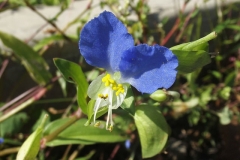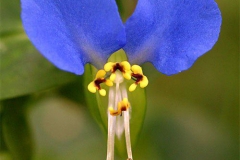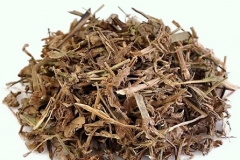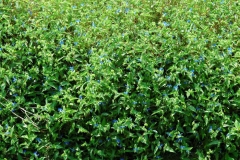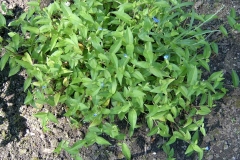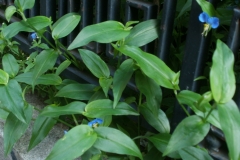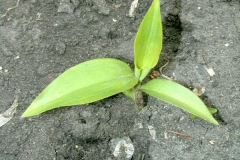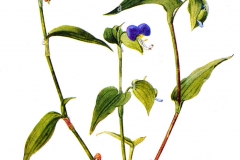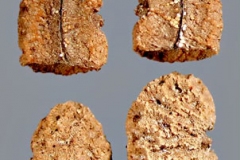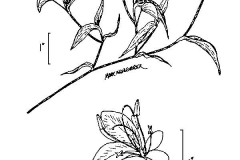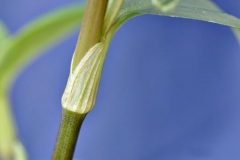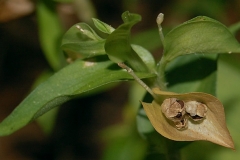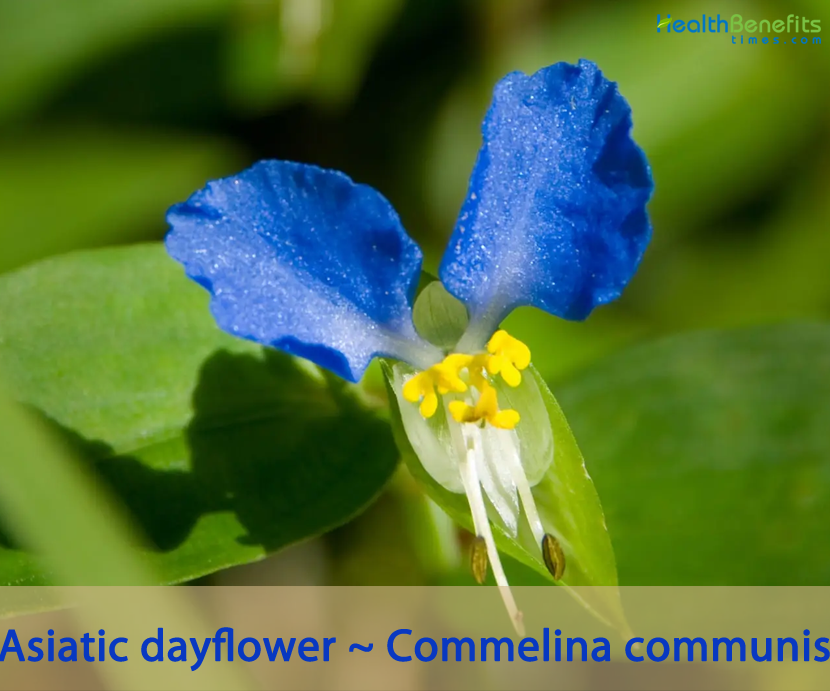 Commelina communis, commonly known as the Asiatic dayflower, is an herbaceous annual plant in the Commelinaceae Mirb. (Spiderwort family). The plant gets its name because the blooms last for only one day. The plant is native throughout much of East Asia and Southeast Asia. Country by country, it is found in China, India, Japan, Taiwan, Korea, Malaysia, Cambodia, Iran, the Russian Far East, Laos, Vietnam and Thailand. Within China it is found in all provinces except Xinjiang, Tibet, Hainan and Qinghai. In Japan the plant is found from Kyūshū to Hokkaido south. In Russia it is found on Sakhalin and in the Far East in areas nearby the Ussuri River. In China, the plant is recognized as yazhicao roughly meaning duck foot herb, whereas in Japan it is known as tsuyukusa which means dew herb. Apart from that it can also be found in much of eastern North America central and southeastern Europe, where it has spread to become a poisonous weed.
Commelina communis, commonly known as the Asiatic dayflower, is an herbaceous annual plant in the Commelinaceae Mirb. (Spiderwort family). The plant gets its name because the blooms last for only one day. The plant is native throughout much of East Asia and Southeast Asia. Country by country, it is found in China, India, Japan, Taiwan, Korea, Malaysia, Cambodia, Iran, the Russian Far East, Laos, Vietnam and Thailand. Within China it is found in all provinces except Xinjiang, Tibet, Hainan and Qinghai. In Japan the plant is found from Kyūshū to Hokkaido south. In Russia it is found on Sakhalin and in the Far East in areas nearby the Ussuri River. In China, the plant is recognized as yazhicao roughly meaning duck foot herb, whereas in Japan it is known as tsuyukusa which means dew herb. Apart from that it can also be found in much of eastern North America central and southeastern Europe, where it has spread to become a poisonous weed.
Some of the popular common names of the plants are Asiatic Dayflower, Day Flower, Common Dayflower, mouse flower, Seven-angled Pipewort, Ator, Danzhuye, Duck’s tongue plant, Gangi gadda, Spider wort, Zhuyecao Yashecao and Thai lai trang. The genus name of the Asiatic dayflower was taken from the last name of three Dutch brothers named Commelin. Out of these three brothers, two became skillful botanists while the third one expired without any achievement. The name is suitable as the two skillful brothers are signified by the inflamed deep blue petals of the bloom while other is symbolized by the reduced white petal. Other common name mouse flower match with positioning as well as shape of the enlarged deep blue petals which actually look like ear of the mouse.
Asiatic Dayflower Facts
| Name | Dayflower (Asiatic dayflower) |
|---|---|
| Scientific Name | Commelina communis |
| Native | East Asia and Southeast Asia |
| Common Names | Common Dayflower, Asiatic Dayflower, mouse flower, Day Flower, Danzhuye, Seven-angled Pipewort, Spider wort, Ator, Duck’s tongue plant, Zhuyecao Yashecao, Gangi gadda and Thai lai trang |
| Name in Other Languages | Afrikaans: Dayflower Albanian: Dayflower Amharic: Yek’eni ābeba (የቀን አበባ) Arabic: Eibad alshams (عباد الشمس), وعلان شائع Armenian: Ts’erekayin tsaghik (ցերեկային ծաղիկ) Azerbaijani: Günəbaxan, Adi kommelina Bengali: Dayflower (dāˌflou(-ə)r), Citrapatrī (চিত্রপত্রী) Bulgarian: Dayflower (dāˌflou(-ə)r), obiknovena komelina (обикновена комелина) Burmese: Nayhkyi (နေခြည်) Chinese: Báihuā (白花), ya zhi cao (鸭跖草) Croatian: Dayflower, komelina Czech: Dayflower, Křížatka obecná Danish: Dayflower Dutch: Dagbloem, Gewone commelina English: Dayflower, Asiatic Dayflower, Common Dayflower, mouse flower, Seven-angled Pipewort Esperanto: Taglumo Estonian: Päevalill, harilik kommeliin Filipino: Mirasol Finnish: Dayflower, Rikkasoljo French: Fleur de jour, Comméline commune, Commélyne commune, commeline vulgaire, misère, misère asiatique Georgian: Dghis q’vavili (დღის ყვავილი), t’q’is ch’ort’ana (ტყის ჭორტანა) German: Tagesblume, Gewöhnliche Commeline, Gewöhnliche Commeline, G. Tagblume, gemeine Commeline, Kommeline Greek: Dayflower (dāˌflou(ə)r) Gujarati: Divasa phlāvara (દિવસ ફ્લાવર) Hausa: Kayan rana Hebrew: פרח Hindi: Dayflower (dāˌflou(-ə)r) Hungarian: Kaszavirág, Azúrkék kommelína Icelandic: Dagblóm Indonesian: Bunga hari Irish: Lus an lae Italian: Dayflower, Erba Miseria asiatica Japanese: Tsuyukusa (ツユクサ), bôshibana (ボウシバナ), Aobana (アオバナ), Tsuyukusa (ツユクサ) Javanese: Awan Kannada: Hagalu hūvu (ಹಗಲು ಹೂವು), Kannesoppu (ಕನ್ನೆಸೊಪ್ಪು) Kazakh: Künbağıs (күнбағыс) Korean: Dei peullawo (데이 플라워), talk ui jang pul, dalg-uijangpul (닭의장풀) Kurdish: Dayîna rojê Lao: Dok tauaen (ດອກຕາເວັນ) Latin: Dayflower Latvian: Dienaspuķe, Parast Lithuanian: Dieninė gėlė, Paprastoji komelina Macedonian: Dnevno cveḱe (дневно цвеќе) Malagasy: Dayflower Malay: Bunga matahari Malayalam: pakal pūv (പകൽ പൂവ്) Maltese: Jum tal-ġurnata Marathi: Dephlovar (डेफ्लॉवर) Mongolian: Tsetsgiin tsetse (цэцгийн цэцэг) Nepali: Dinamukhee phool (दिनमुखी फूल), Mākurō (माकुरो) Norwegian: Dayflower Oriya: ଦିନର ଫୁଲ Pashto: ورځ ګل Persian: گل آفتابگردان Polish: Kwiat dzienny, komelina pospolita Portuguese: Dayflower, tradescância Punjabi: Ḍē aphalāvara (ਡੇਅਫਲਾਵਰ) Romanian: Dayflower Russian: Dayflower (dāˌflou(ə)r), коммелина обыкновенная (коммелина обыкновенная), sineglazka (синеглазка) Serbian: Daiflover (даифловер), komelina (комелина) Sindhi: ڏينهن جي فلاور Sinhala: Divā mal (දිවා මල්) Slovak: križatka obyčajná, podenka obyčajná Slovenian: Dayflower, navadna comelina Spanish: Dayflower, flor de Santa Lucia, siempreviva Sundanese: Mendung Swedish: Dayflower, Liten himmelsblomma Tajik: Coşt (чошт) Tamil: Pakal pū (பகல் பூ) Telugu: Dayflower (dāˌflou(ə)r) Thai: Dayflower (dāˌflou(ə)r) Turkish: Dayflower, mahmuza, Asya gün çiçeği Ukrainian: Odnodennyy (одноденний), komelina zvychayna (комеліна звичайна) Upper Sorbian: Wšědny módrjenk Urdu: ڈے فلاور Uzbek: Kungaboqar Vietnamese: Hoa ban ngày Welsh: Blodyn y dydd Zulu: I-sunflower |
| Plant Growth Habit | Herbaceous annual plant |
| Growing Climates | Partly shaded grassy places, roadsides, cultivated fields,edges of floodplain forests, thickets, edges of gardens and yards, areas along buildings |
| Plant Size | Nearly 3.4 ft. (1 m) long |
| Root | Fibrous root system |
| Stem | Hairless, erect or prostrate |
| Leaf | Lanceolate to ovate-lanceolate 3–9 cm long and 1.5–2 cm wide |
| Flowering season | July to September |
| Flower | Flowers are ½ to 1 inch across and consist of 3 petals. Upper 2 petals are bright blue and round while lower petal is somewhat smaller, white and jagged into 3 rounded lobes |
| Fruit Shape & Size | Two-celled capsules that are elliptic about 4.5–8 mm long |
| Fruit Color | Initially green turning to brown as they mature |
| Taste | Somewhat sweet and bland taste |
| Plant Parts Used | Aerial parts |
| Propagation | By seed and stolons |
| Season | August to October |
Plant Description
Asiatic dayflower is an herbaceous annual plant that normally grows about 3.4 ft. long. The plant is found growing in partly shaded grassy places, low woods, edges of floodplain forests, vacant lots, cultivated fields, roadsides, railroad embankments, edges of gardens and yards, thickets, ridges, fence rows, areas along buildings, vegetable fields, bottomlands, waste areas, orchards, ditches, disturbed soils near waterways, and near dwellings. It is common in disturbed sites and prefers moist soil. The plant has fibrous root system and plants often root at the nodes when in contact with the soil. Stems are hairless, erect or prostrate rising at the tip (decumbent), normally rooting at the nodes. They are thick, fleshy and enlarged at the nodes.
Leaves
Hairless alternate leaves measure about 3–12 cm long and 1–4 cm wide. Leaf blades are narrowly lanceolate, or lance-shaped, to ovate-elliptic, or egg-shaped. Blades are glabrous to puberulent and have slightly rough margins and the veins run parallel. Base of leaf is sessile or clasping, and has a membranous sheath which wraps round the stem. The sheath is nearly 1 inch long and has green longitudinal veins; if not it is white or greenish white. Upper edge of the sheath is hairless, though it has fine upright hairs for a rare variety. Leaves are numerous and are densely arranged.
Flower
Stalked flowers occur single or in small clusters, at the tips of branching stems or from leaf axils on top of the plant. Individual flowers are ½ to 1 inch across and consist of 3 petals. Upper 2 petals are bright blue and round while lower petal is somewhat smaller, white and jagged into 3 rounded lobes. In the middle are 3 small, sterile stamens and a 4th stamen with a bigger, butterfly-shaped tip, all 4 with a spot of maroon in the center of the yellow tip. Beneath are a style and 2 fertile stamens; all 3 are long, bent and yellowish to white.
Behind the flower is a folded, leafy bract that is 2 inches long and is half heart-shaped. Spathe is hairless and open from top to its base. Flowering period occurs in between July to September, and mostly lasts for 1-2 months. Normally flower blooms from the morning for a single day. No noticeable floral scent is found in the flower.
Fruit & Seed
Fertile flowers are replaced by dehiscent, ellipsoid seed capsule that has 2 cells, each cell consists of 2 seeds. Capsule is glabrous, brown and measures about 4.5–8 mm long, and divided into two valves. Seeds are brown or brownish yellow colored and deltoid, or unevenly triangular shaped. Seeds are 2.5–4.2 mm long and 2.2–3 mm across, but seeds as short as 2 mm can also be found. Surfaces are rugose pitted-reticulate and are thickly covered with smaller farinose grains with thin larger farinose granules.
Traditional uses and benefits of Asiatic Dayflower
- Leaves are diuretic, febrifuge and depurative.
- It is used as a throat gargle to cure tonsillitis and sore throats.
- Decoction of dried plant can be used to treat fever, diarrhea and bleeding.
- In China it is used as a medicinal herb with anti-inflammatory, antipyretic, febrifugal and diuretic effects.
- The plant is used as a fodder crop and vegetable in India and China.
- It is often used traditionally to clear heat, remove harmful toxins, and alleviate edema, and cure chickenpox, neuropathic vomiting, pneumonia, bronchitis, tonsillitis, hepatitis, hemorrhagic conjunctivitis, pelvic inflammatory disease, mumps, herpes zoster, sore throat, erysipelas, hematuria, epistaxis and malaria.
- Asiatic dayflower is applied externally for arthritis in Vietnam.
- Sap of the crushed plant is put on inflamed eyes in Indo China.
- Asiatic dayflower is used to combat vertigo, bilious disorders in China and India,
- In Vietnam, India and China it is used as an antidote for snake poisons.
- The plant is used for diabetes due to its hypo glycemic effect in China & Korea.
- An extract after decoction in water is used traditionally for the treatment of diabetes in Korea.
Benefits with other herbs
- It is used together with Shi Gao, Zhi Mu, and Lu Gen to cure high fever and polydipsia caused by heat.
- Along with Jin Yin Hua, Lian Qiao, and Bo He it is used to treat the initial signs of common cold.
- Ban Lan Gen and Xuan Shen are used together to treat sore throat.
- Duckweed and Rhizoma Imperatae when used together helps to promote urination, treat oliguria, edema and painful urination.
- Dryopteris, Huang Qi, She Gan and Ban Lan Gen are used to treat upper respiratory infections and varicella in kids.
- Dandelion and Mulberry Leaf is used to treat pneumonia, upper respiratory infections, and bronchitis.
Culinary Uses
- Leaves, flowers and young shoots are consumed raw or after being cooked.
- It can be chopped finely and included to salads or cooked as potherb.
- The plant has a sweet taste with a mucilaginous touch.
Other Facts
- Bright blue dye is obtained from the petals.
- Due to the unique short life span of the flowers the plant gets its common names.
- Flower bloom nearly for one day, before withering.
Precautions
- People who are sensitive to Ya Zhi Cao cannot use it.
- Individual with deficiency-cold in the spleen and stomach should avoid using it.
- Guidance from a doctor should be taken by Pregnant and breastfeeding women before using it.
- Children, elderly, and sick people must take it under the supervision of a specialist.
References:
https://www.itis.gov/servlet/SingleRpt/SingleRpt?search_topic=TSN&search_value=39127#null
http://www.hear.org/pier/species/commelina_communis.htm
https://pfaf.org/User/Plant.aspx?LatinName=Commelina+communis
https://en.wikipedia.org/wiki/Commelina_communis#cite_note-chinaflora-2
http://www.theplantlist.org/tpl1.1/record/kew-233794
https://www.ipmimages.org/browse/subinfo.cfm?sub=5365
https://gd.eppo.int/taxon/COMCO
https://www.illinoiswildflowers.info/weeds/plants/asia_dayflower.htm
https://www.minnesotawildflowers.info/flower/asiatic-dayflower
https://uses.plantnet-project.org/en/Commelina_(PROSEA_Medicinal_plants)#Uses
https://plants.usda.gov/home/plantProfile?symbol=COCO3


